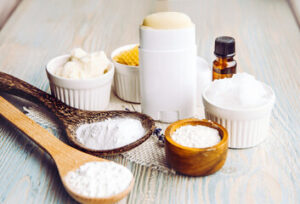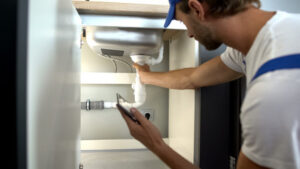Regarding beauty products, ‘natural’ is all the rage. Whether it’s backed by big-name celebrities or a commitment to sustainability, consumers are looking for ways to reduce their exposure to potentially harmful ingredients.

For deodorants, this might mean making the switch to aluminum-free options. Luckily, advances in natural chemistry have made it possible to effectively neutralize body odor without using aluminum. Keep reading the article below to learn more about Aluminum Free Deodorant.
If you’re looking to get rid of chemicals from your grooming routine, consider going aluminum free with a deodorant. These natural options don’t use aluminum and instead fight odor with clean ingredients and help the body detox from the metal. Many of these products are also free from sulfates, parabens and phthalates, which can cause irritation or clog pores. They are often fragranced with natural oils and butters, but some don’t have a scent at all or are unscented for those who prefer to be neutral.
For a gentle yet effective aluminum free deodorant that cares for your underarms, try Dove 0% Aluminum Deodorant. Available in a stick deodorant or dry spray, this non-sticky product provides reliable 48-hour odor protection in a range of beautifully fresh fragrances. Choose Cucumber & Green Tea for an invigorating start to your day, or Pomegranate & Lemon Verbena for a light, fruity scent.
Another option for a aluminum-free deodorant is from the natural skin care brand Tom’s of Maine. This unisex deodorant is free from parabens, phthalates and synthetic fragrances. It contains arrowroot powder and baking soda to absorb sweat, and it’s vegan and cruelty-free. The company is committed to giving back and donates 10% of its proceeds to organizations focused on sustainability and health.
This deodorant from Schmidt’s is another good choice if you want to keep your underarms fresh all day long. It uses natural essential oils and shea butter to minimize odor, and it’s free from sulfates and parabens, as well as phthalates and propylene glycol. It’s formulated with a non-sticky base that doesn’t leave white marks on clothing and is easy to apply.
The last option on our list is this organic deodorant from Dr. Teal’s. This deodorant is made with a blend of nourishing oils and shea butter to moisturize your underarms. It also contains magnesium to reduce odor, as well as arrowroot powder and baking soda to minimize perspiration. It’s also free from sulfates and other harsh ingredients, as well as animal testing.
There’s no definitive evidence linking aluminum in antiperspirants and deodorants to breast cancer, but some studies indicate it may be linked to Alzheimer’s disease and other conditions. So, it’s definitely worth taking the time to read the labels on your current products and make the switch to aluminum-free.
Ingredients
There are a number of reasons why you might choose to use an aluminum-free deodorant. It may be that you have sensitive skin, or that you want to avoid the potential link between aluminum and cancer. You might also be seeking a natural alternative to antiperspirants, which often contain a lot of chemicals that can irritate the skin and disrupt the body’s natural microbiome. These deodorants are usually made from nourishing ingredients like shea butter, coconut oil, and essential oils that help to fight the smell of body odor without irritating or clogging your pores.
In addition to being free of aluminum, these products are typically free from other irritants like baking soda and talc that can cake under your arms. They also don’t leave behind white marks or stains on your clothes, making them a great choice for those who wear dark clothing. Some of these deodorants are also free from alcohol, which can dry out the skin under your arms.
While many people are concerned about the safety of using aluminum-based deodorant, there is little evidence that it is harmful to your health. In fact, there is no definitive connection between aluminum and breast cancer or Alzheimer’s disease. But avoiding aluminum in personal hygiene is still a popular trend, especially for those who have sensitive skin or have had negative reactions to traditional antiperspirants and deodorants.
The most common way to make the switch to an aluminum-free product is by purchasing a natural, organic, or vegan option. These usually have a more natural fragrance and are made from a variety of ingredients, including shea butter, coconut oil, and botanicals. They also often have a lower pH and don’t have any phthalates, parabens, or sulfates.
Some people may find that they need to reapply more frequently than when they used an aluminum-based deodorant, but this is because their bodies are acclimating to the absence of a protective barrier against unwanted sweat and odor. However, you should expect to feel just as fresh and confident with a quality natural deodorant as you would with an aluminum-based one.
Scent
While aluminum was once a mainstay in most antiperspirants, it has been linked to health concerns like breast cancer and Alzheimer’s disease. This caused a shift in the consumer market and led to the growth of natural, aluminum free deodorants. Many of these are available in a range of forms including sticks, sprays and gels. They come in a variety of fragrances as well to suit all preferences.
The best aluminum free deodorants use naturally derived ingredients to prevent body odor, and the majority of them do not contain any alcohol. This is a good thing, as alcohol can be drying for the skin and can also lead to an allergic reaction. They also do not contain any talc, which can be irritating to sensitive skin.
Several of the products in this category use baking soda or activated charcoal to neutralize body odor and inhibit sweating. Others use a gentler alternative such as lactic acid esters to counteract odours and keep you fresh and dry. These ingredients are a lot more gentle on the skin than aluminium chloride and will not cause any irritation.
While it is not necessary, it is a good idea to undergo a detox when switching over to natural deodorants. This will give your armpits a chance to adjust and allow you to discover which ones work the best. It is normal to experience more sweating at first, but this will subside as your body gets used to the new deodorant.
One of the most popular aluminum free deodorants for men is the Cucumber & Green Tea. This product is 96% natural and features a blend of soothing botanicals to control underarm odour, along with volcanic ash to absorb sweat and keep you feeling cool and fresh. You can choose from a range of other naturally scented options as well, including Pomegranate & Lemon Verbena and Cotton Flower & Sandalwood. These non-toxic aluminum free deodorants are available in both a stick and a spray to suit your needs.
Performance
The aluminum-free trend in men’s deodorant is a reflection of a larger movement towards natural, skin-friendly and eco-conscious grooming products. This trend is backed by research that supports the health benefits of using products that are free of synthetic additives, fillers and chemicals.
There are two main health issues usually cited when discussing the use of aluminum in antiperspirant: Alzheimer’s disease and breast cancer. However, recent studies have deemed those claims unreliable and have found no link between aluminum and either of those conditions.
Aluminum is an important part of many antiperspirant formulas because it blocks the sweat ducts and prevents the body from releasing odor-causing sweat. However, there are plenty of options available for men who prefer to avoid it. Aluminum-free men’s deodorants don’t block the pores and instead work to eliminate odor by absorbing sweat and eliminating it through the lungs and urinary tract.
These deodorants typically contain ingredients like baking soda and arrowroot powder to absorb the moisture that causes odors, and many of them offer scents formulated by expert perfumers to leave you fresh all day long. Depending on the product, some may even provide wetness protection.
One thing to keep in mind when switching to an aluminum-free product is that your body’s natural sweating process may take a while to adjust. Some people report a week or so of being extra sweaty while the aluminum-free deodorant takes effect. To help combat this, you can wear breathable clothing and try to reapply frequently throughout the day.
Finding the best aluminum free deodorant for you can be a little bit of trial and error, but it’s worth it in the end. The key is to decide what you’re looking for in a deodorant – wetness protection, odor control or both – and read the label carefully. Also, be sure to consider whether you have any allergies or sensitivities to certain ingredients, especially those related to metals.
Once you find the right product for you, stick with it and be prepared to reapply regularly. It’s also helpful to have a few cleansing wipes in your bag or pocket so you can freshen up as needed.








